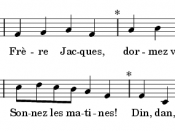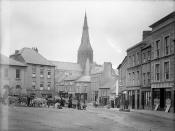This is a preparation for the Abbey Beer Frère Jaques case from the Universiteit Maastricht Marketing exam 2004. 9 pages!
âºMarketing Caseâº
Abbey Beer Frère - Jacques
Questions
1. What in your opinion are the most crucial issues and perhaps questions marks relating to the market evolution and buying behaviour of beer in France?
Are you expecting any changes in the medium or long-term?
o generally the market share go towards the (super) premium beer whereas the Lager market decreases a lot
o total beer consumption dropped by 2.7% between 1989 and 1996
o buying behaviour shifted towards super premium beer with an increase of 56.3% between 1989 and 1996
o the decline is especially strong in the on-trade channel (CHR channel), a 16% decline
o buying behaviour changed from buying beer in the CHR channel to buying beer in the food channel
o not many changes to be expected in the future due to the French culture, and new "In-drinks" (alcopops)
2. How would you interpret the competitive situation in France at the present moment?
What are your expectations for the medium and long term?
o the French beer market is highly competitive with a tendency to become crowded
o in 1998 more than 135 brands were available on the Speciality beer market
o the Premium Lager beers are direct competitors since Frère - Jacques is sometimes perceived as a Premium Lager beer
o there's as well part competition in the Speciality beer branch
3. How would you interpret the marketing environment in France at the present moment?
What are your expectations for the future?
o no commercials on TV and restricted advertising in newspapers allowed because of the "Loi Evin"
o Advertising possible from mouth-to-mouth propaganda
o distribution positively affected by the established Frère - Jacques Cafés
o huge indirect competition of alcohol containing beverages (alcopops)
o the drinking behaviour is going towards to new beverages apart from beer
4. What is / are the problem(s) Frère - Jacques is confronted with in France?
Do you expect any changes in the future?
o decreasing beer market
o French beer consumptions shows strong differences between the North and the South of the country hence a nationwide distribution is not possible
o Restricted advertising in France
o Alcopops
o No changes in the future
5. Which marketing objectives, in what rank order, would you formulate for Frère -Jacques in France for the immediate future? For the medium ( 3 years) and long term ( > 5 years)
(1) retaining customers by satisfying them
(2) increasing market share by creating a competitive advantage
(3) rise of brand awareness
Product level objectives
(1) hold blond (cash cow)
(2) build selectively or harvest ( long term) brown, triple, furieux
6. Would you follow a market segmentation strategy? And how would you position Frère - Jacques in France?
Why is this and do you expect any changes in the future?
o profile geographically segmentation
south East in contrast to the rest
urban areas ( small vs big cities)
food channel vs on-trade channel (CHR)
o behavioural segmentation
o psychographic segmentation
lifestyle
7. Which policy would you follow regarding the different marketing mix instruments in France?
What about the medium and long term?
o Price:
- going rate pricing (going with the competitors in the super premium markets) to maintain Frère-Jaques' image
o Product:
- different packaging in different channels (evolved over time)
- stick to the original recipe that was created 800 years ago
- adapted the size of the bottles to the on-trade channel in France
- maintained the same bottle size as in Belgium for the CHR-channel due to lower production costs
o Place:
- own cafes
- preference of the food-channel
- urban areas
o Promotion:
- own cafes
- promotional packing ( the 4 different flavours in one battle, 4 pack comes with an extra glasses)
- providing pubs with fridges, signs, glasses, ashtrays etc.
- advertising in/ newspapers, billboards, posters
- 1990 was a changing point, much more capital was invested in promotion and the major strategy experienced a change
8. Would you suggest any marketing research of an occasional or more recurrent nature in France? Why is this and do you foresee any changes in the future?
- we would recommend an occasional marketing research due to:
1. beer market is in a stable environment
2. low level of uncertainty despite high level of competition
3. to see if promotion actions like 4 different flavours in one package appeals to customers
9. Which possibilities do you envisage for international expansion? What about medium and long term?
- enter the east European market
- small possibilities to enter any other west European markets, since the beer market in those countries (e.g. Germany) is already highly established
1) Marketing
product- oriented
market-driven business
customer-value : image benefits ; product benefits ; monetary costs
delighters ( promotional special offers)
self-image ; pleasure
Marketing Mix
4 P's
2) Marketing Planning: an overview
Where are we now?
How did we get here?
Where are we heading?
Where would we like to be?
How do we get there?
Are we on course?
SWOT-Analysis Fig.2.4
=>strength: established in several markets; market leader in speciality beer market; brand name awareness, cafes (additional retail option), long brand history
weaknesses: depends on one product (blonde)
threats: highly competitive market, limited advertising, decreasing beer consumption
opportunities: market expansion (East EU), speciality beer market growing
possibilities conversion: develop sales in other beer products
matching strategy: bringing different beers to existing market; use of experience to gain more market share
Marketing Objectives
Strategic Thrust - Market Penetration/Expansion
Strategic Objectives - building, holding
3) Understanding Consumer Behaviour
Ehrenberg und Goddhardt: low level involvement - repeat purchase model Fig. 3.3
Influences on consumer behaviour
- social influences: culture, social class, reference groups
- personal influences: lifestyle, beliefs and attitudes, motivation, personality
4) Marketing Research
.....
7) Marketing Segmentation and Positioning
Target Market Selection
Consumer Segmentation:
1) Behavioural
=> purchase occasion (bar, supermarket)
=> perceptions and beliefs
2) psychographic
=> lifestyle
=> personality
3) profile
=> geographic
Organizational Segmentation
1) Macrosegmentation
=> geographic location (Paris, then france-wide)
2) Microsegmentation
Market Attractiveness
Market Factors
segment size - French market
segment growth rate - speciality beer market growing
barriers to market segment entry - difficult for new competitors due to strict advertising laws
Competitive Factors
Nature of competition - high
Political social economical Factors
political issues - laws
undifferentiated marketing mix - same mix for France
Keys to successful positioning
- consistency: since 800 years
- competitiveness: trappist-beer
- credibility: accepted as speciality beer
- clarity: no! target market?
8) Managing Products
product line: Frere Jaques line - brown, blonde
manufacturer brand: self-produced
creating a brand
- packaging: different types of packaging
- brand name and image: special beer, brand name-superpremium beer!!
brand positioning
brand domain: target market France
brand reflection: speciality beer
brand assets: history
brand heritage: history, background (abbey)
PLC
Introduction-growth: several beers (product awareness/trial, creating trial, expand market
Maturity stage: blonde!! (hold, protect share, brand loyality, differentiated, maintaining awareness/repeat purchase, distribution intensive
Ansoff Matrix: Existing Product / New Market Market Development
Strategic options for increasing sales volume:
Market Expansion: Convert Non-users
Market Penetration: Win competitor's costumers
11 PRICING
Competitive pricing strategy: apply prices to competitors
Layers of competition: (p. 394):
- Immediate competitors: speciality beers, esp. trappist/abbey beers
- Secondary competitors: alcoholic beverages esp. beer (lager) and wine
- Tertiary competitors: beverages (quench thirst), drugs (help costumers to reach delirium)
12 Advertisement
until 1990 low budget for advertisement, after 1990 increasing expenditures on advertisement.
Advertisement only possible (in restricted ways) through printed media
Promotion: special packing to attract new costumers and hold existing costumers
22 Int.
Why France?
Same language, brand name could stay the same, no domestic abbey beers in France, geographically close,
Adapted to local (French) bottle sizes and advertisement restrictions, standardized bottle and keg sizes for CHR channel
1. Marketing Audit
I. External Marketing Audit
Macroenvironment
Economic: No informational available
Social / Cultural: - the beer consumption is higher in the north than in the South
- the number of pubs is higher in the East ( ), the
south-west, rather than in the South-east
Political/Legal: - advertising is limited: no advertising in TV and Cinemas
- limited rights for advertising in the press: only product related
information
- Drinking Age 16
II.The Market
In general: decreasing beer market but increase in the specialty beer segment
Market size: - current (1997) 21250
=> Food: 13980
CHR: 7270
Specialty beer: - current (1997) 1745 (8.2%)
=> Food: 820 (5.9%)
CHR: 925 (12.7%) Just the market overview,
Growth Rate: - current (1997): -3.8% NOT ABBEY
=> Food: -2.6%
CHR: -5.8%
Trend dev.: - '89-'96: -2.7
=> Food: -6.3%
CHR: -16 %
Customers : - customers from the North buy more than the customers from
the south
- the CHR Channel (pubs) is least developed in the South-East
- buy in the Food-channel (retail)
- buy in the CHR-channel
Market Segmentation: - grouped on customer basis
- the beer market in France :
The Beer market
Lager beer premium beer Super Premium Liters N/A
62% 26% 8% 2% 2%
Food channel
CHR Channel
Distribution: - Food channel Current: -2.6%, '89-'96: 6.3%
- CHR Channel Current: -5.8, '89-'96: -16%
=> Food channel is more attractive since it supports a higher volume and show a
positive trend
Competition: - Highly competitive market (decreasing beer market, increasing part of specialty beers)
- 135 brands on the specialist beer market
- tends to become more crowded
- Competitor's strength (approximately):
- high brand awareness (desperados)
=> competes against global player
- No real competition on the Trappist beer market (specialty beer market)
- indirect competitors by other specialty beers
(only if you consider Trappist beer a market on its own)
- Since Frère-Jacques is sometimes perceived more or less as a Premium Lager beer
(as is 1664), it may not only experience indirect but also rather direct competition
from up-market Lager beers.
Profitability: - the food channel is more attractive than the CHR channel
Entry barriers: - high advertising regulations
III Internal Marketing Audit
Market share: * 75% in the market of Abbey and Trappist beers (absolute market leader)
* 18% in the market of specialty beers
IV. Strategic Issue Analysis
Marketing objectives: 1. Strategic thrust: - market penetration or expansion
=> more customer loyalty
more brand awareness, people are more exposed to
the brand
attracting new customers
2. Strategic objectives: - build or hold (for the Blond)
=> growth of maturity stage of the PLC
Market segmentation: Changed from
Psychographic (lifestyle and personality)
Profile based segmentation based on geographical data
Competitive advantage: - Frère-Jacques is market leader in the segments Abbey / Trappist beer
- Origin and recipe
- established brand in the market
Core Competences: ?
Positioning: - Where? (Target markets):
- French beer market
French specialty beer market
French Abbey Trappist beer market
- How?
- Differential advantage
V Portfolio Analysis
Product lines (turnover): - Blond: Food 75% CHR 95%
- Brown: Food 10% CHR 2%
- Triple: Food 10% CHR 2%
- Furious: Food 5% CHR 1%
Implemented in the Boston Consulting Group Growth-Share Matrix
Stars: - build sales/market share
- invest to maintain or increase
leadership
- Repel competitive advantage Problem Children:- build selectively
- focus on
defendable niche
- harvest
Cash Cows: - Hold sales and market
share
- defend position
- use surplus cash to
support the stars Dogs : - harvest or divest
- focus on defendable niche
Blond is a star (probably) and Brown, Triple and Furious are Dogs
Though not enough information available to support or reject this
VI. Marketing Mix The four P Approach
Product: - Product line includes Blond, Brown, Triple and Furiuex
- Packaging: Food-channel 25cl-one-way bottles
=> adaptation to market
Blond and Brown are also available in 75cl bottles
=> differential advantage
CHR-channel kegs 20l or 30l (only Blond and Brown)
- returnable 33cl bottles for all flavors
=> standardization / cost saving
Price: - market oriented pricing
- twice the price of traditional lager (compared to Belgium)
=> premium price
- price differs from packaging units (food channel)
- price differs from packaging units and kind of outlet (CHR channel)
Promotion: - classical conditioning (linking information to emotions) is only possible in the cafés
- operant conditioning for new potential customers, brand awareness through new papers
- advertising is limited by law
change from atmosphere related themes to product related themes
=> effective: sales increase
- Sales promotional: Food channel
recruiting new customers and intensifying consumption by
legal customers: coupons, supermarket testings, collection of
points to receive a valuable gift, etc.
CHR channel:
use of branded POS material (werbegeschenke)
trade promotion with free equipment (glasses, refrigerators)
Place: - good development in Paris
- Make Frère Jacque available all over the country
- 36 cafes of Frère Jacques
- intensification
SWOT Analysis:
Strengths - market leadership in specialty beer
- high sales growth
- brand awareness
- historical background (differential advantage)
- heritage
- packaging
- cafés (additional retail and promotion option)
Weaknesses - portfolio is not balanced (relies too much on the star)
- undifferentiated marketing
- different prices
Opportunities - specialty beer market increases
- relatively many pubs in the east, the west and the south-west
- food channel increases
- entry barriers for competitors
- no local competition
- open more cafés in the south-west region (lowest bar/people ratio)
Threats - limited advertising
- decreasing beer consumption
- competition in the specialty beer market increases
- CHR channel decreases
Conversion strategies:
Internal: - balanced portfolio by differentiated marketing
=> gain market share with the other flavors
- avoid price differentiations by "recommended retail price"
External: - advertise for more beer consumption in general
- open new cafes in the south-west region
- try to stimulate the CHR channel
- develop competitive advantages
Matching strategies: - use the market leadership position and brand awareness to develop market
share in the increasing food channel


